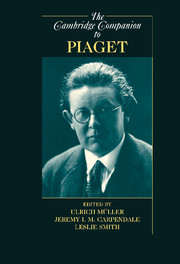Book contents
- Frontmatter
- 1 Introduction: Overview
- 2 The Historical Context Of Piaget’s Ideas
- 3 Piaget’s Developmental Epistemology
- 4 Piaget’s Biology
- 5 On the Concept(s) of the Social in Piaget
- 6 Piaget on Equilibration
- 7 Constructive Processes: Abstraction, Generalization, and Dialectics
- 8 Piaget and Method
- 9 Infancy
- 10 Childhood
- 11 Adolescence
- 12 Piaget’s Theory of Moral Development
- 13 Piaget’s Enduring Contribution to a Science of Consciousness
- 14 Piaget and Affectivity
- 15 Piaget’s Pedagogy
- 16 Piaget in the United States, 1925-1971
- 17 The Mind’s Staircase Revised
- 18 Dynamic Development: A Neo-Piagetian Approach
- Index
18 - Dynamic Development: A Neo-Piagetian Approach
Published online by Cambridge University Press: 28 March 2010
- Frontmatter
- 1 Introduction: Overview
- 2 The Historical Context Of Piaget’s Ideas
- 3 Piaget’s Developmental Epistemology
- 4 Piaget’s Biology
- 5 On the Concept(s) of the Social in Piaget
- 6 Piaget on Equilibration
- 7 Constructive Processes: Abstraction, Generalization, and Dialectics
- 8 Piaget and Method
- 9 Infancy
- 10 Childhood
- 11 Adolescence
- 12 Piaget’s Theory of Moral Development
- 13 Piaget’s Enduring Contribution to a Science of Consciousness
- 14 Piaget and Affectivity
- 15 Piaget’s Pedagogy
- 16 Piaget in the United States, 1925-1971
- 17 The Mind’s Staircase Revised
- 18 Dynamic Development: A Neo-Piagetian Approach
- Index
Summary
The questions Piaget raised, and his concepts and observations for addressing them, have shaped virtually all research and theory in cognitive development over the last 50 years. Even those who rejected Piaget's conclusions shaped their work in terms of his questions. Some approaches built upon his work directly whereas others sought to oppose it. The focus of this chapter is primarily on the former - research and theory that has built directly on Piaget to address new, revised, and expanded questions.
The primary question raised in neo-Piagetian work is variability: the dynamic ways that people's actions differ and change. At all ages and in all cultures, people's actions vary dramatically across contexts, tasks, and emotional states. For example, in class Christina, a fifth-grade student, can read and explain a paragraph about how the eye works, but she cannot give the same explanation at home on her own. Seth, a high school freshman, can solve a math problem about the cost of schoolbooks when he does it with his mother's support, but in class the next day he is unable to solve the same problem. On the other hand, for a similar problem about the cost of new jeans, he solves it easily across all situations. This sort of variation can be frustrating, but it is normal, and it happens every day with everyone. Modern neo-Piagetian research and theory embrace this variability, using it to create better explanations of the complexity and diversity of human knowledge and action.
- Type
- Chapter
- Information
- The Cambridge Companion to Piaget , pp. 400 - 422Publisher: Cambridge University PressPrint publication year: 2009
- 21
- Cited by



